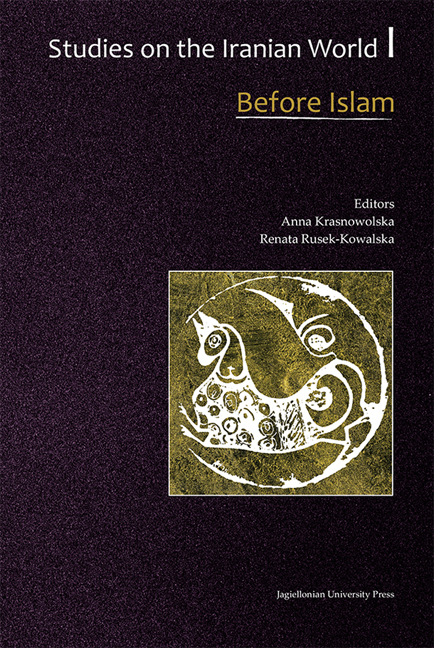Book contents
- Frontmatter
- Contents
- Foreword
- Linguistics
- Literature
- Religion
- History
- Wahrām Čōbīn the Rebel General and the Militarization of the Sasanian Empire
- A Tale of Two Great Kings: Artabanus and Vologaeses
- Realia for Sasanian History: Mint Networks
- New Data on the Development of the Indo-Iranians in the Bronze Age
- Archaeology
Wahrām Čōbīn the Rebel General and the Militarization of the Sasanian Empire
from History
Published online by Cambridge University Press: 12 January 2018
- Frontmatter
- Contents
- Foreword
- Linguistics
- Literature
- Religion
- History
- Wahrām Čōbīn the Rebel General and the Militarization of the Sasanian Empire
- A Tale of Two Great Kings: Artabanus and Vologaeses
- Realia for Sasanian History: Mint Networks
- New Data on the Development of the Indo-Iranians in the Bronze Age
- Archaeology
Summary
SUMMARY
The following essay discusses the importance of the rebellious general, Wahrām Čōbīn who in the late sixth century CE challenged the Sasanian throne. Contrary to what has been suggested, Wahrām appears not to be important because of his place in Middle Persian and Persian literature as a hero and a savior, but as this paper attempts to show, was the earliest manifestation of the militarization of the Sasanian Empire in the late sixth century which eventually lead to its decline in the seventh century CE.
In August 589 CE Wahrām Čōbīn was defeated against the Romans in the Albania and in matter of months staged a mutiny which has captured the imagination of the surviving sources on late antique history of the Near East. We are told he was belittled by the Sasanian king of kings, Hormizd IV as a result of his defeat, furthered by jealousy of the king and / or his advisors. The mockery could have also simply been the result of Wahrām not sending the proper amount of booty from the eastern campaign against the Turks. Wahrām consequently took the unprecedented step in taking the road to Ctesiphon to meet the Sasanian king who had belittled him. According to D. Frendo, on February 6th 590 CE, just before arriving to the capital, the Sasanian nobility blinded and deposed Hormizd, and then placed his son, Khusro II on the throne. As our most important source, Sebēos, which J. Howard-Johnston has called the work the ‘History of Khosrov,’ states that Wahrām was rapidly arriving, ‘like the swoop of an eagle (khoyanal artsui),’ and so the young Khusro Parwēz (not a parwēz by any means yet), was taken away from the capital by his uncles, Wistahm and Vindōe.
The Sasanian general, Wahrām Čōbīn boasted to be from the Mehrān family, and may have used his lineage as a means of legitimacy in claiming some sort of case against the king. Theophylactus Simocatta, however, suggests that Wahrām was attempting to undo the unlawful usurpation of Khusro II, but we know that Wahrām appears to have wanted to assume the Kayānid crown for himself. In a letter to Khusro it is reported that Wahrām had said: ‘come to us and you will at once become a regional commander of the Persian state.’
- Type
- Chapter
- Information
- Studies on the Iranian World: Before IslamMedieval and Modern, pp. 193 - 202Publisher: Jagiellonian University PressPrint publication year: 2015



